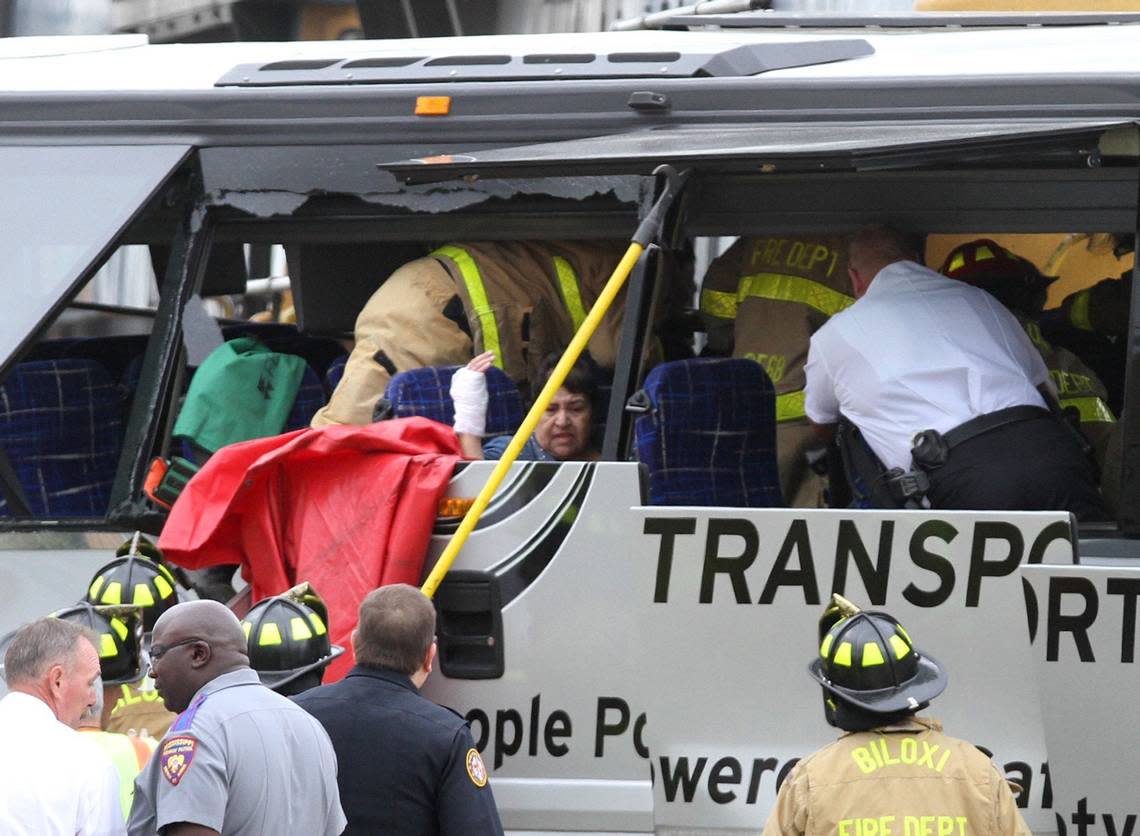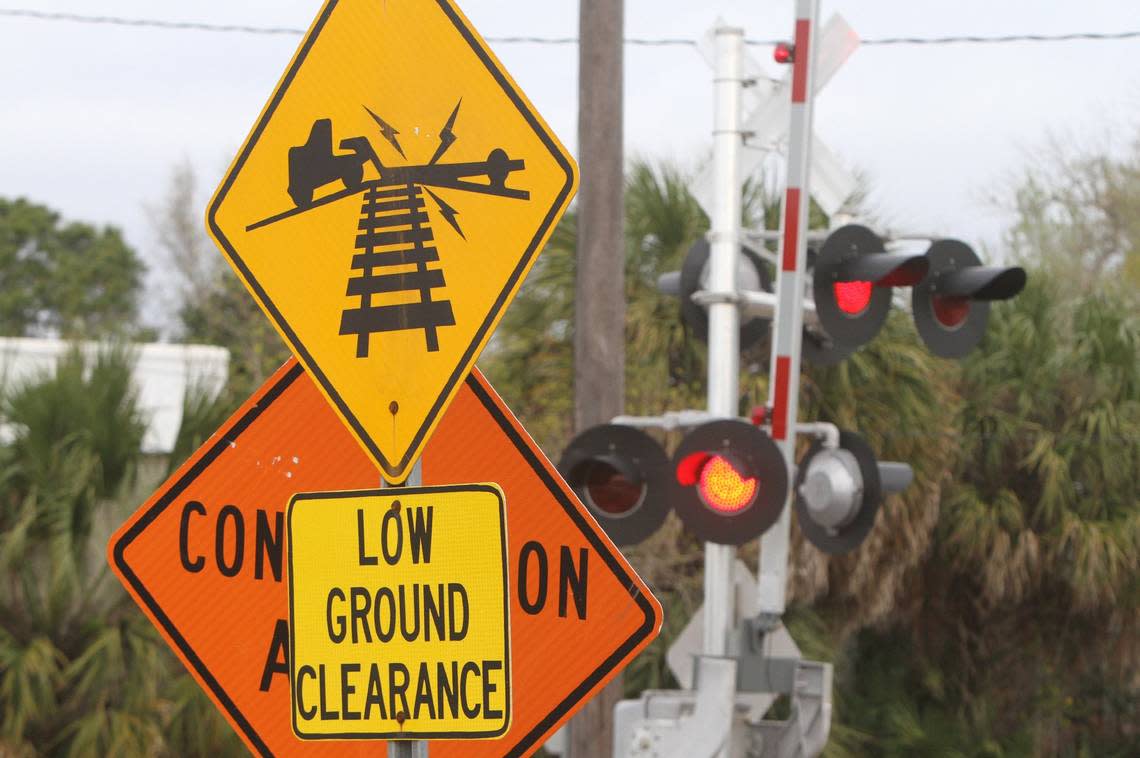Train hit bus, killed 4 at steep Mississippi crossing. It’s still not fixed after 5 years
A steep railroad crossing, a tour bus full of seniors and an intersection that locals had repeatedly complained about turned into a deadly combination in Mississippi five years ago.
And like the derailment in Mendon, Missouri, in June, this deadly crash shows what can happen when officials don’t heed the warnings and complaints from the public about dangerous crossings.
Shortly after 2 p.m. on March 7, 2017, the motor coach from Texas carrying 49 passengers got stuck on the tracks at a steep crossing in Biloxi. The driver tried to rock the bus back and forth to break it loose but it wouldn’t budge, according to a National Transportation Safety Board investigative report.
As a CSX freight train with three locomotives and 52 cars heading from New Orleans to Georgia hurtled toward the bus, the driver opened the loading door and told passengers to get out. But because of their age — the tourists were 50 to 88 years old — and limited mobility, only six passengers made it off before the train rammed the bus, pushing it 259 feet down the track.
Video from a camera on the bus showed that three of the tourists who died were trying to get down the front steps when they were ejected upon impact and run over by the motor coach and locomotive. Another died of injuries sustained while standing in the aisle at the time of impact, the NTSB report said.

Though the crossing had gates, lights and bells, it had been a concern for years because of the steep grade approaching the track, the safety board found. But despite the warnings, it wasn’t improved.
The intersection — known as a “hump crossing” — was similar to the one in Mendon, where an Amtrak train slammed into a dump truck nearly six months ago. That crash killed the driver and three passengers on the train and injured more than 150.
Small fraction of crashes get NTSB investigation
Another similarity among the crashes in Biloxi and Mendon is that the NTSB conducted an investigation, which can be rare when it comes to railroad accidents, The Star found.
An independent federal agency, the board is charged by Congress with investigating all civil aviation accidents and “significant accidents” in other modes of transportation, including railroads, according to the NTSB’s website.
Despite the fact that a large portion of railroad accidents are fatalities, the vast majority don’t get that federal scrutiny. And now, the NTSB wants to do even fewer railroad investigations so it can focus more on cases that can result in critical safety recommendations.
“Our investigations are very extensive, very detailed, comprehensive investigations, and they take time; they usually take 12 to 18 months, sometimes longer than that,” said Thomas Chapman, an NTSB board member. “So that’s one of the reasons we want to ensure that the statutory mandate in terms of our jurisdiction is more targeted than it is right now.”
Last year, the agency investigated only 14 of the 1,887 railroad accidents it has been mandated to do. Of those, 728 were determined to have a limited safety benefit, and 1,145 weren’t investigated because of limited resources, it said.
The safety board is asking Congress to “amend the current NTSB rail investigative authority to provide that accidents at railroad grade crossings, or which involve rail trespassers, are not accidents for which Board investigation is mandatory.” Doing so, it said, would better focus the NTSB’s mandate and resources.
In Biloxi, many vehicles over the years have gotten stuck on the crossing where the tour bus crashed. One woman said a Mardi Gras float in the past had become lodged on the track and people jumped off before a train slammed into it, according to a media report.

The city had originally scheduled a meeting for the very day of the bus crash to discuss a proposal to close six of the 29 rail crossings across the town that were considered the greatest safety concerns.
The hump crossing where the crash occurred had not even made that closure list.
NTSB finds railroad, city didn’t act
At a news conference after the 2017 bus crash, NTSB member Robert Sumwalt said the collision was the second time in two months that a train had hit a vehicle at that crossing. In the previous incident, he said, a CSX train hit a tractor-trailer that was hung up at the intersection. The driver got out and called for help, but the train couldn’t stop in time.
Federal Railroad Administration records show that there have been 18 crashes at that crossing in more than four decades. In addition to the 2017 crash, one person was killed there in 2003 and one in 1983.
The NTSB released its report on the crash after 17 months, saying “the probable cause was the failure of CSX Transportation and the city of Biloxi to coordinate and take action.”
“Their inaction led to the grounding of the motorcoach that was subsequently struck by the CSX Transportation freight train,” the NTSB said in its findings. “Contributing to the circumstances of the crash was the inadequate guidance from the Federal Highway Administration on how to mitigate the risks posed by grade crossings with high vertical profiles.”
In the five-year period before the crash, the NTSB found, there had been 27 incidents of vehicles becoming stuck on that crossing, three resulting in collisions. And 24 of the total grounding incidents occurred after February 2014, when maintenance performed by CSX raised the track elevation.
The NTSB issued 11 new recommendations to prevent future crashes at such crossings, including the suggestion that railroads and highway safety groups establish criteria to determine when a crossing is so dangerous that it should be closed, rebuilt or repaired.
CSX spokeswoman Sheriee Bowman told The Star that the railroad submitted a “petition for reconsideration” of several of the NTSB’s findings.
“CSX disagreed that there was evidence that track work performed in 2014 increased the crossing’s vertical profile and resulted in more vehicle groundings,” Bowman said in an email to The Star.“ CSX also disagreed with the Report’s unsupported suggestion that CSX in any way prevented MDOT or the City from addressing any low clearance issues at the crossing.”
In addition, the petition said that CSX and the city of Biloxi had looked into potential crossing closures, but the city had decided not to close that one.
It’s been more than five years since the fatal Biloxi crash, and the grade at the crossing is still steep.
The Mississippi Department of Transportation told The Star that safety upgrades for the crossing are included in the state’s current Highway-Rail Grade Crossing Action Plan.
A $756,000 contract was recently awarded to a construction company to make the approach to the crossing less steep, MDOT said, and work is expected to begin soon.
